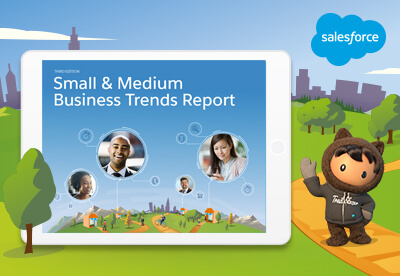
Boost your company's culture with these 7 steps
While a small team can thrive in a start-up culture, you need to lay the groundwork for a productive company culture when your head count increases significantly. In 1999, Salesforce was still a startup in a small San Francisco apartment. Over the next few years, the company scaled rapidly to more than 400 employees in multiple locations. Our company culture allowed us to maintain a healthy, thriving and productive culture while scaling at speed.
This article uncovers some unique insights from Salesforce’s own start-up to enterprise story, as a guide for small and medium-sized business owners.
1. Clear company values will foster a culture of productivity
Here at Salesforce, trust is a core value. This trust also encompasses our productivity culture, meaning we trust our employees to hit their targets.
We also believe that this culture of trust organically extends to our customers. We aim to offer the most trusted infrastructure in the industry as well as to inspire trust in our customer relationships through transparent communication.
Our other core values include customer success, innovation and equality. Customer success is absolutely critical for ensuring our customers are happy, so it’s not just a goal, it's a company value.
Equality is crucial: as you scale your company, you need to have a culture where everyone is treated as equal - and that isn’t limited to the recruitment process. Employees from all walks of life should feel happy in every work environment and championing equality is a great place to start.
2. Sharing the bigger picture with your teams will inspire trust
As your company grows, it can be tricky to keep everyone on the same page, but this is the goal to strive for. At Salesforce, we accomplish this by sharing the bigger picture: every employee should have access to the company's goals at all times. By being this transparent, you inspire trust and team collaboration.
In order to share the bigger picture with all of our employees, we use the V2MOM process. V2MOM is an acronym for vision, values, methods, obstacles, and metrics.
This model helps ensure our business plan is fully transparent to each employee, and their role in it is clear. All employees in the company have their own personal V2MOM that feeds into the company V2MOM, and all V2MOMs are visible to everyone else in the company in our V2MOM mobile app.
Check out our Growth Toolkit to learn more.
3. Focusing on collaboration and avoiding silos will increase productivity
Give your team the best chances of keeping productive by equipping them with the right tools.
We use our innovative CRM across all our departments to get a 360 view of our customers. Every employee has the right data at the right time.
Using team collaboration tools like Quip and Chatter keep our teams organised and seamlessly integrated with all departments.
Our powerful analytics and reporting capabilities also allow managers to see KPIs and reports at a glance, and keep teams on track to hit their targets. These tools also help track and foster employee productivity.
4. Promoting open, honest and frequent feedback will lead to great communication
High-performing teams always have one thing in common: great communication. If your team encounters issues, they need to be able to communicate them without their competency being called into question.
Adding a constant feedback loop to your company culture allows project managers and department heads to remove any obstacles to work efficiency; for example, if the workload is too high. Your team needs to feel that they have somewhere to go when they need help.
Our effort to create an open culture has contributed to making Salesforce one of the best places to work in Australia and New Zealand.
5. Creating a culture of learning will boost satisfaction and engagement
6. Fulfilled employees equal efficient employees
We know that happy employees are more productive and at Salesforce we work really hard to boost employee engagement and try to offer perks that are not just financially beneficial, but actually mean something to our teams.
One great example is our commitment to support our employees to give back to their communities (see next step). We also reimburse professional development expenses for those who want to further their education, and offer extra health benefits. We hold ourselves to a high standard and review our packages every year to ensure our team gets the best.
7. Creating a Volunteer Time Off (VTO) program
Salesforce has committed to donating 1% of its product, equity and employee hours to philanthropic causes. This 1-1-1 philanthropic model adds up to seven days of paid time off a year for each employee that they use to give back to the causes they care about.
Find out how you can create a VTO program here.
Salesforce Resources





